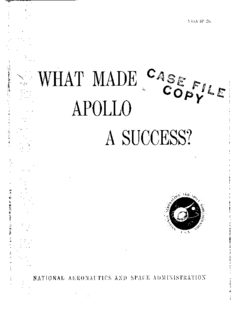Table Of Contenthttps://ntrs.nasa.gov/search.jsp?R=19720005243 2019-04-06T00:13:19+00:00Z
\
WHAT MADE
It- _.
APOLLO
A SUCCESS?
=__
_t
U.S.A.
NATIONAL AERONAUTICS AND SPACE ADMINISTRATION
NASA SP-287
WHAT MADE
APOLLO
A SUCCESS?
A series of eight articles reprinted by permission from the March 1970 issue
of Astronautics & Aeronautics, a publication of the American Institute of Aero-
nautics and Astronautics
1,2_- _
Scientific and Technical Information O/]ic__ 19-'1
NATIONAL AERONAUTICS AND SPACE ADMINISTRATION
Washington, D.C.
For sale by the National Technical Information Service, Springfield, Virginia 22151 - Price $3.00
CONTENTS
Section Page
1. INTRODUCTION ............................ 1
By George M. Low
DESIGN PRINCIPLES STRESSING SIMPLICITY ........... 15
o
By Kenneth S. Kleinknecht
TESTING TO ENSURE MISSION SUCCESS .............. 21
o
By Scott H. Simpkinson
. APOLLO CREW PROCEDURES, SIMULATION, AND FLIGHT
PLANNING ............................. 31
By Warren J. North and C. H. Woodling
FLIGHT CONTROL IN THE APOLLO PROGRAM .......... 41
o
By Eugene F. Kranz and James Otis Covington
ACTION ON MISSION EVALUATION AND FLIGHT
.
ANOMALIES ............................ 53
By Donald D. Arabian
TECHNIQUES OF CONTROLLING THE TRAJECTORY ....... 59
o
By Howard W. Tindall, Jr.
FLEXIBLE YET DISCIPLINED MISSION PLANNING ........ 69
o
By C. C. Kraft, Jr., J. P. Mayer, C. R. Huss, and
R. P. Parten
iii
TABLES
Table Page
1-I DEVELOPMENTANDQUALIFICATIONTESTS........... 3
1-II HISTORYOF ENVIRONMENTALACCEPTANCETEST
FAILURES .............................
1-III APOLLO FLIGHT ANOMALIES ...................
3-I LUNARMODULEACCEPTANCEVIBRATIONTEST
IN 1967............................... 23
3-II COMMANDANDSERVICEMODULEACCEPTANCEVIBRATION
TESTIN 1967 ........................... 24
3-III CRITERIAFORLUNAR MODULEQUALIFICATIONAND
ACCEPTANCETHERMAL TESTINGIN 1967 .......... 25
7-I MANDATORYGUIDANCE,NAVIGATION,ANDCONTROL
SYSTEMS
(a) Lunar modulesystems .................... 62
(b) Commandandservice modulesystems ........... 63
8-I APOLLOSPACECRAFTFLIGHT HISTORY............. 72
iv
FIGURES
Figure Page
1-1 Vibration test level for acceptance ................... 4
1-2 Thermal test level for acceptance ................... 4
1-3 Results of vibration acceptance tests for 11 447 tests of
166 different components ......................
1-4 Results of thermal acceptance tests for 3685 tests of
127 different components .......................
1-5 Apollo 10 fuel-cell temperature oscillations as they originally
appeared in flight ..........................
1-6 Disturbance of Apollo 10 fuel-cell temperature as it was
identified in the laboratory ..................... 7
1-7 Buildup of Apollo mission capability .................. 9
2-1 Mission Control Center, Houston, Texas ............... 17
2-2 Service propulsion engine propellant valve and injector ........ 18
2-3 Command module hatch ......................... 19
3-1 Revised Apollo acceptance vibration test guidelines ......... 23
3-2 Revised Apollo acceptance thermal test guidelines .......... 25
3-3 Results of acceptance vibration tests for 11 447 tests of
166 different components ...................... 26
3-4 Results of acceptance thermal tests for 3685 tests of
127 different components ...................... 26
3-5 Installation of the acceptance-tested crew equipment in the Apollo
command module at the NASA Manned Spacecraft Center ..... 27
4-1 Astronaut trains underwater in simulated zero-g condition in
water-immersion facility. Astronaut wears weights on shoulders,
wrists, and ankles. Total ballast is about 180 pounds ....... 32
4-2 Lunar landing training vehicle trains crews for last 500 feet of
altitude in critical moon landing phase ............... 33
V
Figure Page
4-3 Lunar module mockup installed in KC-135 aircraft. Support
structure takes loads imposed in 2-I/2g pullup, after which
zero g is achieved for 20 to 30 seconds on a parabolic flight
path .................................. 33
4-4 Familiarization run on the mobile partial-gravity simulator used
for lunar walk indoctrination .................... 34
4-5 Apollo 12 landing and ascent model of Surveyor and Snowman
craters as seen from 1800 feet ................... 36
4-6 Command module procedures simulator and lunar module
procedures simulator ........................ 36
4-7 Translation and docking trainer simulates lunar module active
docking over lasti00 feetof separation distance .......... 37
4-8 Dynamics crew procedures simulator ................. 37
4-9 Simulated command module crew stationfor thedynamics crew
procedures simulator ........................ 37
4-10 Lunar module mission simulator with crew stationand Farrand
opticalsystems for three windows ................. 38
4-11 Visual opticsand instructorstationfor command module mission
simulator ............................... 38
4-12 Apollo 12 landing and ascent visual simulation system ........ 38
5-1 Electricalpower display when Apollo 12 was at an
altitudeof6000 feet ......................... 42
5-2 Mission-development time line ..................... 43
5-3 Mission Operations Control Room divisions .............. 44
5-4 Partial sample of CSM systems schematic .............. 45
5-5 Sample offlightmission rules ..................... 47
5-6 Sample of FlightControl Operations Handbook ............. 49
5-7 Sample of FlightController Console Handbook ............. 50
5-8 Sample ofprogramed-instruction text ................. 51
5-9 Logic offlightcontrol decisions .................... 52
vi
Figure Page
6-1 Mission evaluation roomwith team leaders' table in theforeground
anddiscussion ofa systemproblem in thebackground....... 54
6-2 Long-range photographyof adapterfailure during the
Apollo 6mission .......................... 56
7-1 Stepsthe ground-basedflight controllers take if certain guidanceand
control values exceedpremission limits for the LM during
LM descentto the lunar surface .................. 65
Iterative mission-planning process .................. 69
74
Apollo mission designinstrumentation ................
vii
Description:APOLLO. A SUCCESS? A series of eight articles reprinted by permission from the DEVELOPMENT AND QUALIFICATION TESTS. for 11 447 tests of is a game of "what-if's. " What if the computer fails ? What if the engine.

